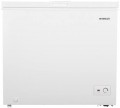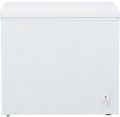Hanging baskets
One or more removable baskets that are attached to the top of the freezer compartment.
Hanging baskets are made of both metal and plastic and are designed to store shallow frozen items or frequently used products that require quick access. Hanging baskets are also used to separate different types of contents.
Minimum temperature
The lowest temperature that the freezer can maintain in normal operation. First of all, the duration of food storage in the freezer depends on this parameter: it is believed that a temperature of -12 ° C is enough to preserve food for a month, -18 ° C – 3 months, -24 ° C – up to a year. At the same time, it must be taken into account that not only temperature affects the shelf life but also the type of product and its quality before freezing.
Freeze capacity
One of the main indicators of freezer performance is the approximate amount of fresh food that the freezer can completely freeze from room temperature to the minimum operating temperature in 24 hours. For domestic use, a power of 10-15 kg/day is considered quite sufficient. More performant models may be required if you have to freeze a lot of food at a time or for industrial purposes.
Controls
The type of control provided in the freezer. This parameter is specified by the type of controls and their location.
- Rotary knobs. In general, this is the simplest and most inexpensive option used in units of the appropriate level. However, even this is quite enough - especially if the freezer works in more or less constant temperature conditions (for example, in a home or office kitchen). In many cases, the matter is limited to selecting the appropriate knob position once and then not changing the settings. In addition, the major advantages of this type of control are reliability and ease of repair.
- Push-buttons. Push-buttons are considered more advanced than rotary knobs. The specific functionality of freezers with such a control may be different. But among them, models with additional functions and the ability to fine-tune the temperature are noticeably more common. As for the location, there are internal and external push-buttons. The internal location allows you to hide the control panel behind the refrigerator door, providing a neat appearance with a minimum of protruding parts.
The external location is convenient because you do not need to open the door to access the settings. On the other hand, the real need for such an arrangement is not so often, and the control panel must also fit into the overall design of the unit (which is not always possible to do in the best way).
- Touch controls. Touch controls are considered th...e next step in the development of control panels, after buttons. So, it looks stylish and technologically advanced, they do not need to be pressed hard (just touched), and there are no protruding parts, corners or slots on the surface of the panel, which simplifies cleaning from dirt. The presence of a touch panel is typical mainly for models of the middle and top levels. It costs a little more than a push-button one, but this is imperceptible against the total price of the units. But the internal location, in this case, is much less common than the external one. It is because there is no need to hide the touch panel behind the door. It can easily fit into the design of the device. In addition, external placement allows you not to open the door again to access the settings.
Energy consumption per year
It is the average amount of energy consumed by the freezer in a year of operation. Of course, these figures are not absolutely accurate. The actual power consumption may vary depending on the specific operating conditions. However, this parameter makes it possible to evaluate the consumption of the device and compare different models with each other. At the same time, it often turns out to be more convenient and visual than the energy consumption class (see above) because, in this paragraph, we are talking about a specific figure (from which you can also calculate the cost of electricity consumed).
Climate class
The climate class to which the freezer corresponds.
As the name implies, this parameter describes the environmental conditions for which the unit is designed. The warmer it is around, the more powerful the freezer should be and the better thermal insulation it should have. Specific classes are indicated by letters. Here are the most popular options:
— SN (subnormal). Models for a cool temperate climate have an operating range from +10 °C to + 32 °C. Such a unit can be useful in a poorly heated room where the temperature can drop below +16 °C — for example, on the veranda of a private house, in a garage, etc.
— N (normal). Freezer for a temperate climate, with an operating temperature range of +16...+32 °C. Such a unit is suitable for most residential apartments and houses in mid-latitudes.
— ST (subtropical). Models for subtropical and humid tropical climates. Normally they work at the range of external temperatures +18...+38 °C.
— T (tropical). Refrigerators for dry tropical climates. Designed for temperature range +18 °C to +43 °C.
Also, note that there are many models on the market with an extended temperature range covering several classes. For example, a unit labelled N-ST will have a temperature range of +16...+38 °C. These freezers are indispensable in climates, conditions which are not covered by one standard class — for example, in cold winters and hot summers.

